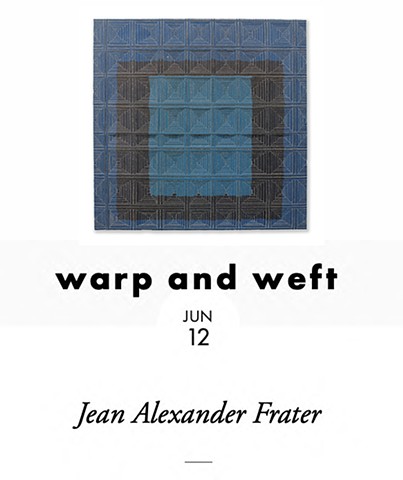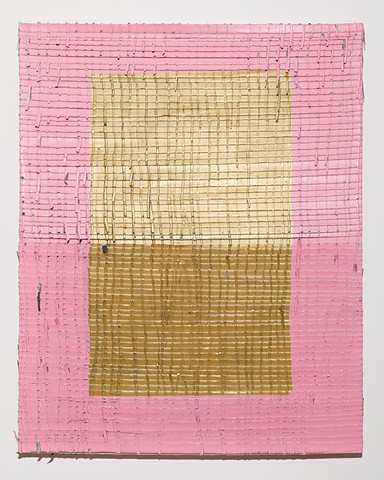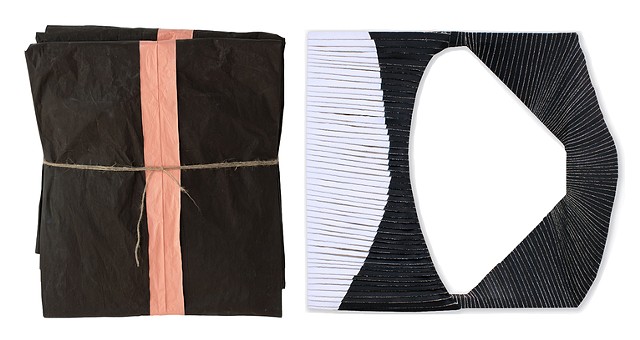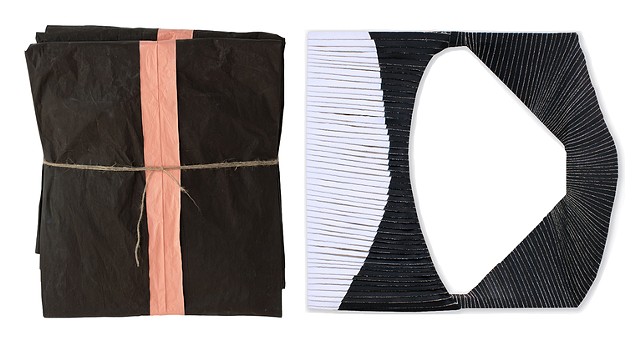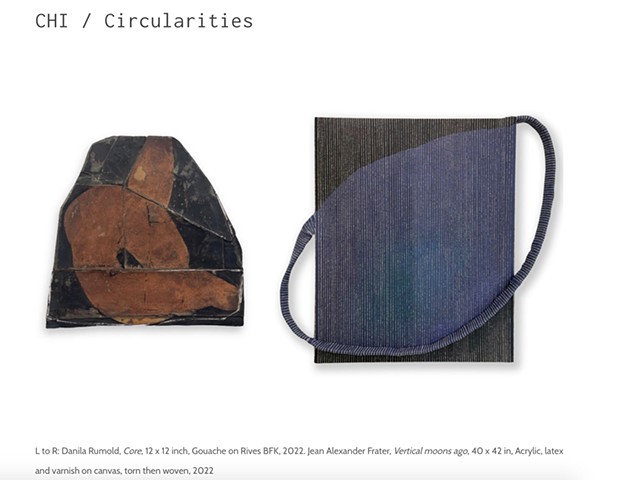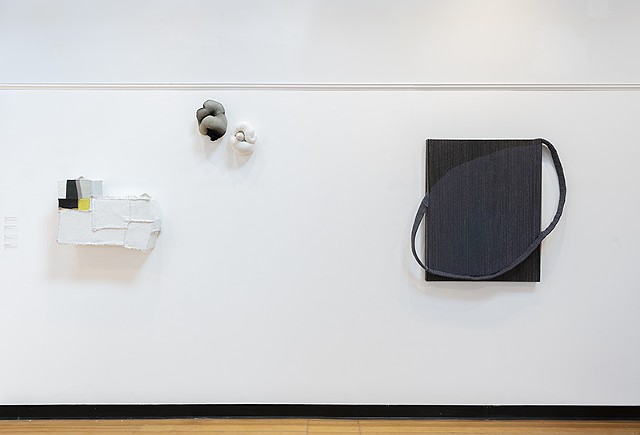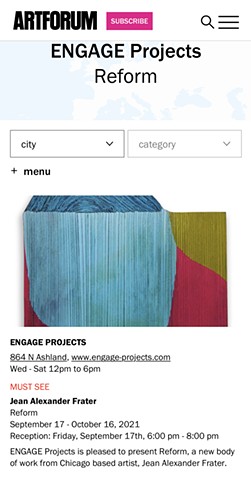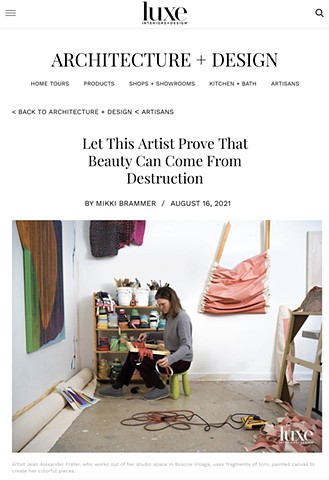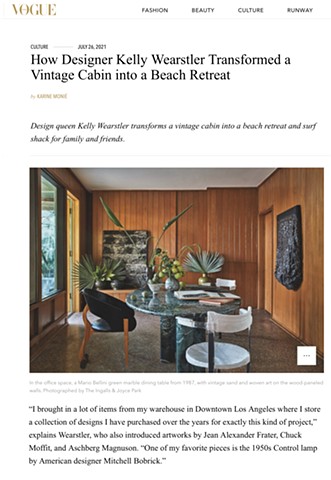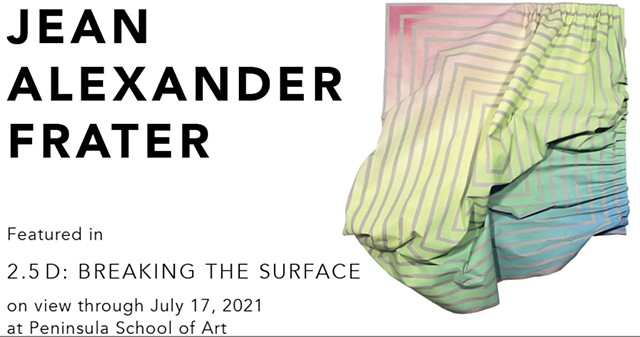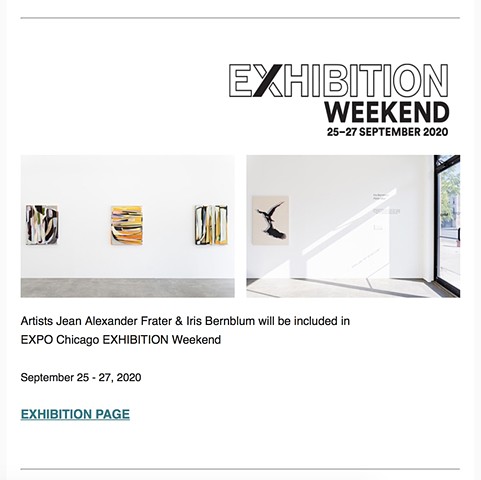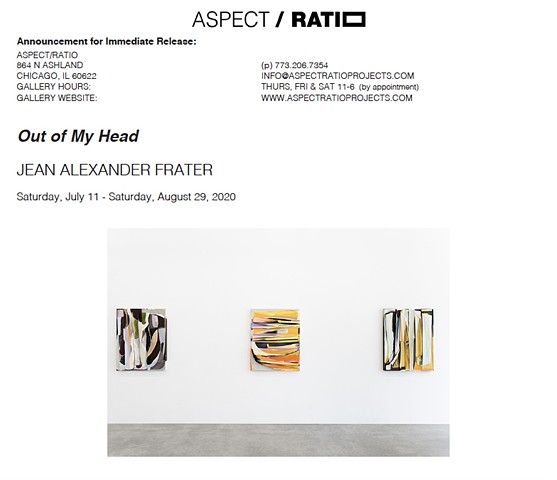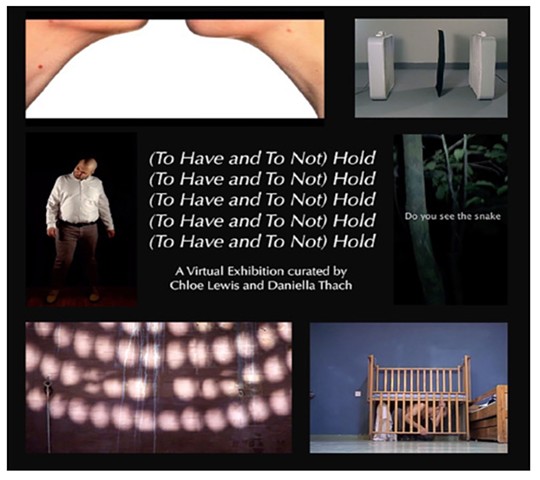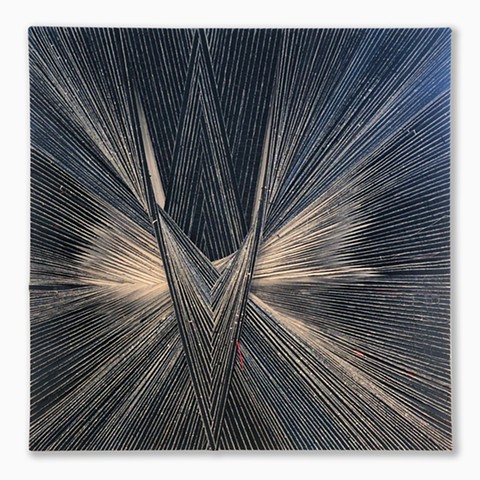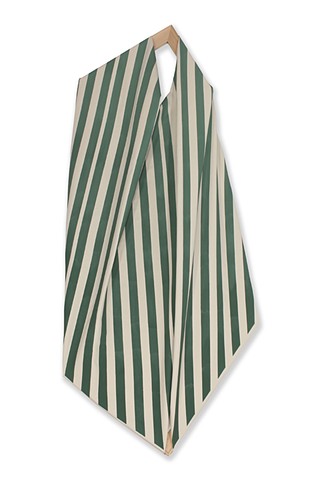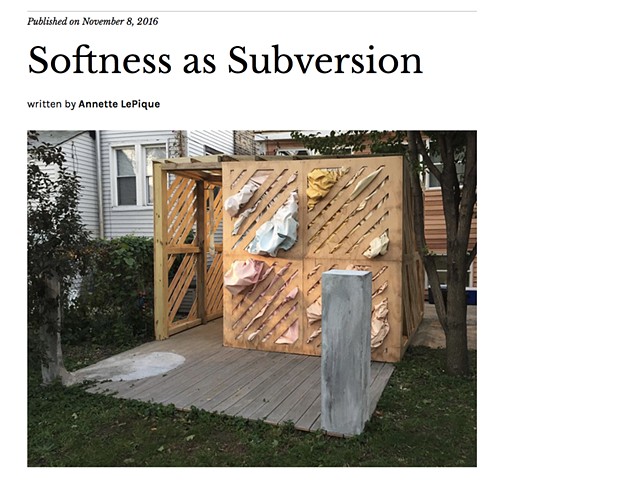Read Full Interview
"Wee Restless Hours" The Mission Projects
April 5th - June 14th
themissionprojects.com/exhibition/129/w…Field Notes, Warp and Weft June 12, 2023
Link to read full article here
1. How did you discover weaving and was what your greatest resource as a beginner?
My painting practice has always had an aspect of structuralism; I deconstruct the materials of a painting as well as the lexicon of Painting, as a way to engage in building up meaning through form and language.
About 20 years ago, I began painting directly on un-stretched raw canvas. I think this directness with the canvas, though still acting as the support to the paint, made me approach everything differently. The canvasses’ inherent materiality could not be ignored. I began experimenting in different ways of how one makes a painting. I wanted to highlight the support, and prioritizing the cotton fabric became my focus. I started folding and manipulating the canvas in various ways. This experimentation resulted in an excess of painted canvas. Both out of frustration, and out of limited resources, I started tearing up my paintings. Weaving the colorful strips was the next move. I liked the idea that the paintings held gestures of both destruction and care.
2. How do you define your practice – do you consider yourself an artist / craftsperson / weaver / designer / general creative or a combination of those? Is this definition important to you?
I consider myself a Painter.
This designation places the objects I make (Paintings) in a specific art historical tradition which hosts many imbedded hierarchies including: chosen material, gestures privileged, subject matter depicted, angular or rectilinear picture plane, etc,. I like subverting these hierarchies by using different traditions, forms, gestures. While sometimes the approach can be considered irreverent, I think it is also very open and expansive. The techniques of weaving, for example, have opened up my painting practice into new territories which I find exciting and full of possibilities.
GAVLAK Los Angeles, February 11 – March 25, 2023
Think Pinker
February 11 – March 25, 2023
Exhibition LinkGAVLAK Los Angeles is thrilled to announce the group exhibition, Think Pinker, curated by Beth Rudin DeWoody. The show opens on February 11 and will continue through March 25, 2023. An open house will take place on Saturday, February 11, 2023, from 10am to 6pm.
Think Pinker is a revisitation of the exhibition and collaboration between Beth Rudin DeWoody and Sarah Gavlak, Think Pink, which took place in 2010. Thirteen years later, we will highlight the color in another immersive installation, this time in Los Angeles.
DeWoody says, "Ever since I curated Think Pink at Gavlak Gallery, Palm Beach in 2010, I've been thinking about doing a sequel. When Sarah and I decided to curate Think Pinker at her Los Angeles gallery this year, I was excited to see how many artists are still working in that color. Pink is bright, fun, and playful—the perfect color to express a more positive, rosy picture of the world today."
Sarah Gavlak says, “It is no mystery that pink is my favorite color. It is feminine and feminist. Pink has its own rainbow of hues from light to dark, powder to powerful, bubble gum to shocking Schiaparelli. From pussy bows to pussy riot, pink has finally become an acceptable hue in the greater culture since the Think Pink exhibition Beth curated in 2010. I am absolutely tickled pink that Beth and I could collaborate again on this ambitious exhibition.”
For this iteration artists include: Tunji Adeniyi-Jones, Jose Alvarez (D.O.P.A.), Sadie Barnette, Jennifer Bartlett, Gina Beavers, Larry Bell, Lynda Benglis, Megan Bogonovich, Andrew Brischler, Deborah Brown, Tammi Campbell, Nacho Carbonell, Kelly Chuning, Jake Clark, Gisela Colón, Cooper Cox, József Csató, Aaron Curry, E.V. Day, Rory Devine, Fred Eversley, Ryan Flores, Jean Alexander Frater, FriendsWithYou, John Geary, Aaronel deRoy Gruber, Alteronce Gumby, The Haas Brothers, Marcia Hafif, Channing Hansen, David Hicks, Nir Hod, Sara Issakharian, Xylor Jane, Jay Kvapil, Rachel Lachowicz, Steven and William Ladd, Mathieu Lehanneur, Steve Locke, Charles Lutz, Yassi Mazandi, Kim McCarty, Matt Momchilov, Maynard Monrow, Ron Nagle, Kenneth Noland, Minga Opazo, Rachel Owens, Irving Penn, Paola Pivi, Jackie Rines, Donald Robertson, Brian Rochefort, Neal Rock, Robert Russell, Ebony Russell, Marty Schnapf, David Benjamin Sherry, Anthony Sonnenberg, Alice Tippit, Vadis Turner, Leo Villareal, Andy Warhol, Pae White, Brittney Leeanne Williams, Rob Wynne, Rosha Yaghmai, Seungjin Yang, Jason Yarmosky, Ye Zhu Qin, and Monsieur Zohore, among others.
Arts and Conversations, January 31
Arts and Conversations
Jean Alexander Frater & Margaret Welsh in Conversation with Jennifer Armetta from Engage Projects
January 31, 2023
By Invitation
6-7:30pm
Event Details
Each opening night will start with cocktails from 6-7:30 p.m., guests will need to register here.ENGAGE Projects, January 13-February 24
Centered.
January 13-February 24, 2023
Exhibition LinkENGAGE Projects is pleased to present Centered. a two-person exhibition featuring work by Jean Alexander Frater and Margaret Welsh. Both a beginning and a destination, the ‘center’ is a measure of balance—of weight, of composition, of well-being. The center is a point of overlap between art and life.
Tertiary colors will fill the gallery in organic shapes and parceled compositions, both vibrant and resistant in their departure from popular culture. Foregrounding the medium itself, the exhibition explores painting as a form of objecthood. Alexander Frater and Welsh speak a feminist vernacular, choosing to engage more surface while occupying less space with their work. Themes of expansion and contraction act as foil to one another while punctuating a larger question of what it means to inhabit space. Reflecting on the politics of physical and social landscapes, Centered. contemplates space as a shared resource in which the ‘center’ exists in abundance as a fluid point defined by one’s own equidistance within a chosen community.
Alexander Frater and Welsh will be part of the Arts & Conversations talk in Palm Beach on January 31st. Sharing the mission to demystify the art world and uphold accessibility as a priority, ENGAGE Projects returns for our third year in partnership with the Arts & Conversations program.
*Artforum Must see
Centered. is curated by Jennifer Armetta.
Tiger Strikes Asteroid, October 15 - December 3
Circularities
October 15 - December 3 (closed Thanksgiving weekend)
Opening Reception: Saturday, October 15th, 1– 4 p.m.
Exhibition LinkCircularities Virtual Panel Discussion: Thursday Dec 1, 2022 ⋅ 7pm – 9pm
Tiger Strikes Asteroid Chicago is pleased to present Circularities, an exhibition that considers female abstraction as a space for revelation in work by Jean Alexander Frater and Danila Rumold. The paintings presented here do not hide their mechanics, rather they showcase how they’ve been built, thus creating a meaningful resonance between their monumentality and their delicacy. As in motherhood and grief, these works blur the lines between the roles, bodies, spaces, and timelines of their makers.
Through observation, fragmentation, and repetition, Frater Alexander and Rumold envision new realities that expand the present with assured nods toward the future. Their unique handling of a wide range of media results in irregular circle shapes, formed as if through mutual agreements amongst the various materials. What might be perceived as logical, defined processes are in fact intuitive intertwinings of construction, deconstruction, and reconstruction, which invite you in by revealing their essences. Just like being sucked in for hours by a jigsaw puzzle or awestruck by new music, each of these artists open up spaces for our thoughts and anxieties to dissolve, unravel, repeat, and reconfigure; they demand that time be taken. Their works guide us to look at the road ahead, take a deep breath, and, hopefully, find new wisdom in the ongoing worries that are intrinsic parts of life, allowing space for revelation to occur.
Circularities is curated by Karen Dana Cohen.
Aurora Art Center, September 2 - October 8
EXHIBITION DATES:
September 2- October 8, 2022
EXHIBITION LOCATION
Third Floor Gallery
David L. Pierce Art & History Center
20 E. Downer Place, Aurora IL 60505The Aurora Public Art Commission will host Resilient, an exhibit showcasing the works of three acclaimed Chicago-based artists: Monica Rezman, Jean Alexander Frater and Bobbi Meier.
The public is invited to attend two free events during which they can meet the artists. An opening reception will be held September 2nd, 6-9pm, during Aurora Downtown’s First Friday event. An artist panel discussion will be held Saturday, September 24th, 2-4pm. A collectible exhibit catalogue will be published following the closing of the exhibit."
Curator Jenn Byrne shares, “For each of these artists, decades of commitment to their craft, both informed by and challenged by the multiple roles women play, has led to the development of uniquely sophisticated yet relatable approaches to story-telling through textiles. Rezman, Meier, and Alexander Frater move without boundaries between two- and three-dimensional fields; I see this innovation, shared amongst all three artists, as a result of the laid-back wisdom and sense of humor one earns over years of experience releasing expectations and adapting to life’s constant changes.”
ArtForum Must See
Artist Feature in Luxe Interiors + Design Magazine
Anyone who happens to be in the vicinity of artist Jean Alexander Frater’s Roscoe Village studio space will likely hear an unusual, repetitive sound. It’s her ripping up a painted canvas, over and over again. “I have to tell my studio mates when to wear earphones because it’s really loud,” she laughs.
It may sound like Alexander Frater is destroying art, but this is just the beginning of her process. To create her tactile abstract works, the Chicago artist staples a canvas to the wall and paints it in latex, acrylic or varnish so that it takes on a leather- or vinyl-like appearance. Then the destruction begins. She “disrupts” the canvas, tearing it into strips and weaving it on to a stretcher. At times she uses a taut weave; other times she folds and ripples the pieces. “Instead of starting with a pre-made shape, the already-painted canvas determines what that shape is going to be,” she says.
The aim is what Alexander Frater calls an “experimental physical curiosity,” pushing the structural limits of painting by considering the pigment, canvas and bars as individual materials and exploring how they work together. She loves the idea that her work juxtaposes the violent process of tearing with the more traditional and gentle process of weaving. “I like to use these two paradoxical concepts to kind of create a conversation or a problem,” she says.
Using mostly tertiary hues, Alexander Frater admits that her color choices are often influenced by simpler things, such as the weather or her mood. But sometimes—like in her 2017 show, “Softer”—they’re loaded with symbolism. “I wanted to think about what were typically feminine colors,” she says. “And what that meant and how that situated itself within the history of art.”
Above all, the artist hopes that the happiness she feels when working with material and color translates to the viewer’s experience. “A lot of it has to do with just bringing joy,” she says. “Color is so evocative of all kinds of things.”
Link to article:
luxesource.com/artist-jean-alexander-fr…
Jean Alexander Frater Woven painting featured in Kelly Wearstler Cabin, Vogue
Link to the article below:
2.5 Breaking the Surface, Peninsula School of Art, Curated by Crystal Chesnick
Artists who typically work in two dimensions—those who are trained in drawing, painting, and print-making—are masters of compressing the three-dimensional world into a flat surface. But, what happens when artists used to working on planes apply their unique perspective to sculpture? 2.5 D: Breaking the Surface attempts to answer this question, presenting work that falls somewhere between image and sculpture
Click link for Video Interview with Jean Alexander Frater
InterviewAspect Ratio Projects Represents Jean Alexander Frater
EXPO Chicago, September 25 - 27th 2020
Video Walkthrough Out of My Head, Jean Alexander Frater @ Aspect/Ratio
Out of My Head
Aspect/Ratio is pleased to present Out of My Head, a new body of work from artist Jean Alexander Frater. Staying within their own geometric constraints, these paintings shift the process and address support, gesture, and frame. Support takes a leading role here, with allusions to the body and architecture. Historic 20th C. painting references abound in these wildly abstract works with subtle figurative leanings. Out of My Head also shifts away from Alexander Frater’s performative practice of painting that addresses the image. Hence, the image is constantly in-flux where a line can be a cut and is contorted in the process.
Jean Alexander Frater is a Chicago based artist whose painting practice has deep roots in her sculptural background. This is Alexander Frater’s second solo/two-person show at Aspect/Ratio as she has had solo shows at The MISSION, and has been included at group exhibitions at institutions including The Wexner Center for the Arts, Rockford Art Museum, and Orange County Center for Contemporary Art. Alexander Frater was also featured in New American Paintings and was the recipient of a BOLT residency at Chicago Artists Coalition. Works from Jean Alexander Frater are included in the collection of the DePaul Art Museum as well as many private collections and public commissions.
(To Have and To Not) Hold
A VIRTUAL GROUP EXHIBITION
Curated by Chloe Lewis and Daniella Thach
April 24 - June 06, 2020
Aspect/Ratio is pleased to present (To Have and To Not) Hold, a virtual group exhibition curated by Chloe Lewis and Daniella Thach. Showcasing video art and video performance art from Guy Ben-Ner, Iris Bernblum, Alejandro Figueredo Díaz-Perera, Jean Alexander Frater, James Murray, and Casilda Sánchez, this virtual exhibition explores feelings of isola- tion, containment, and the physical need to release energy brought on by solitude. The fragile nature of our curret climate sets in motion these works which examine senses comparable to those heightened during a quarantined existence and serve as visual representations of some of the emotional states felt in this shared experience. Returning to our roots as a traditionally video based gallery,
(To Have and To Not) Hold opens virtually
Friday, April 24, 2020. Can be accessed on Vimeo in the link below.
https://vimeopro.com/aspectratioprojects/to-have-and-to-not-hold
password: videoart
Degroot Fine Art Interview
December 17, 2019
In Good Company: Jean Alexander Frater
Interview52 Critical Painters, by Kevin Smith
Jean Alexander Frater, June 16th, 2019
www.kevvvin.net/52criticalpainters/jean…Scio Spotlight: Bringing the work of local Chicago artists home
Spotlight on Jean Alexander Frater
Jean Alexander Frater: FOLD; Don't Spindle and Mutilate
Review of "Softer"
Jean Alexander Frater,
by David B Zarley
New American PaintingsWhat it looks like is, ok, like the hurried ancillary sculpture of an active hand, like a Monument to a Moment, the slip—in the course of creation—of fabric, the errant falling and perfect, frozen fantastic memory of a bolt in some divine designer-artist's atelier, a static haint of a kinetic flourish, the same ephemeral, cigarette-smoke beauty we find curling from a hot cherry or in the letting down, the glorious, luxurious exhale, of an up-do or cascading over the side of some steep embankment, Niagara, Victoria, Angel; it looks like the terrible, painful Monument to a Moment One Would Rather Forget, like a broken arm—the radius and ulna snapped through, the spasming, spider-sprayed-with-bleach digits dangling, the grotesque thing held together by extensor and flexor carpi radialus, flexor and extensor pollicis longus and brevis, radialii, digitorums, palmaris longus, pronator teres, the lonely exertions of the biceps brachi—but only when viewed with the negative and corporeal in mind; it looks like mis-caught pizza dough, with its pallid spine draped over the hand like an examined necklace, or a sea cucumber being garroted, and only all of these things—minus the textile—if one ignores the colors, the combination of GO Transit green and raw, creamy canvas, which gives it a Gilded Age flair even as gravity leaves it dangling in its belly, but what Green Stripes Event (so perfectly named!) does not look like, at first blush, is a painting; it's obviously painted, of course—those stripes aren't woven, didn't come from nowhere—and has those various things a painting would have, where it to be broken down anatomically—and it is the protrusion, like a compound fracture, of the painting's support, broken at the top, dangling at the bottom, which gives it both its injurious and closet-ready qualities, although the former is far more important, and keeping with the spirit of the show, than the latter—but it does not sit like a painting, compose itself as a painting should, back straight, belly tight, against the wall, a tidy lie, telling us that it exists in two dimensions… - B. David Zarley, Chicago Contributor
Jean Alexander Frater has no interest in the lie; Softer, her new solo show at Chicago gallery THE MISSION, features paintings which exist, fully and whole-heartedly, albeit ever-so-stylishly, in three dimensions. Her folded canvas hover away from the walls with a materiality and occupancy of space which is downright sculptural. The skeletal system of the average art work, the stretcher bars and supports, is up-ended; her canvases undulate and fold, living and breathing rather than stretched taunt and yearning.
With the sails unfurled, observers are invited to not only ignore the limitations placed on paintings, but to paradoxically notice them more; the playing with the supports and strictures brings them front and center, and the resulting paintings are so enjoyable as to make one wonder where the cruel ideal of stretching a poor canvas for all of its life ever came from in the first place, much less became comme il faut.
Alexander Frater's works are brachycephalic, bulldogs and pugs—replete with compelling and expressive brows, folds, and curves—in a world of greyhounds and pinschers. They accomplish, in as little as one of her hand-made folds, the ever-lasting job of pushing painting up hard against, and through, its definitions. Softer accomplishes this on a conceptual level, as well; meticulously thought out and painted with the eventual folds in mind, the works on display are, in effect, sculptures, Alexander Frater manipulating all aspects of the form like the exceedingly rich do the law.
As Freeark Gallery Director Claudine Isé notes in her companion essay, Alexander Frater's folds add the necessary dynamism and picture-plane breaking that Spatialist artists used to achieve with, for example, brutal slashing, in a far gentler manner. Moving with gravity and physics rather than fighting hard against them, accepting a canvas and paint more as what they are than what we wish them to be, her works utilize the softness of the medium, so often buried, to create paintings which not only require, but actively inspire, a more thorough and pleasant level of engagement.
The fold is a gentle action with lasting and devastating consequences, as anyone with a sartorial bent but an active life (or neglected clothes storing procedure) can attest to; it is a quiet scarring, and something transformational, almost magical, each gravid swell giving birth to a new angle, shadow, interplay, idea cresting its hills. A fold can turn, as Isé aptly notes, a stripe into a ripple, and a ripple has a long, reverberating effect that a cut or a pull can only ever dream of, vibrating angrily away.
Softer features a, well, soft palette, all corals and cornflowers, rich peroxide bottle browns and structures-by-the sea, purples and oranges which mitigate over the course of their travels across her folds into subtle, healthy glows. The color choice is inviting, bright, relaxing, insidious.
See, everything about Softer is in fact an assault, a strike against the arteriosclerotic, the breaking of the bones of the skeleton and the strictures and the structures, paintings which are defiantly sculptures, a fluid riposte like the sea against the shore; the colors, the folds, the technical expertise, all have merely served to cushion the blow.
B. David Zarley is a freelance journalist, essayist, and book/music/art critic based in Chicago. You can find him on Twitter (@BDavidZarley) and at bdavidzarley.com.
Review: Softness as Subversion, November 8, 2016

